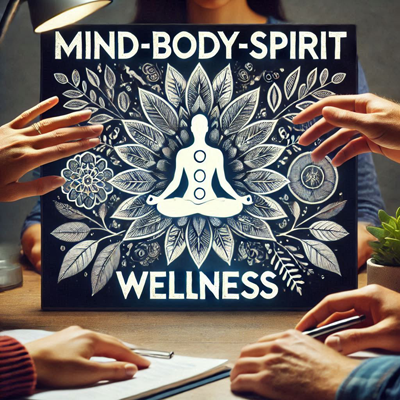The key to mind-body-spirit wellness is to realise that you are a whole, multidimensional being. Mind, body, and spirit are not separate but exist as one continuum. You can lose your sense of wellness when you disregard this interconnection, especially when you become trapped in your mind, reacting to endless thoughts and disconnecting from your body and spirit. When you are disconnected from your three-fold nature, or these three dimensions are not fully integrated, you will struggle to master your key life challenges and will often end up feeling unfulfilled, frustrated, depressed, or unwell. This is why mind-body-spirit wellness, the integration of these three dimensions of your nature, is essential for your life to be fully on track.
Here’s how to increase your mind-body-spirit wellness with three key steps.
Step One: Practise Mindfulness
Mindfulness is the practice of consciously directing your attention, from your observer self, on your inner and outer experience in the present moment without reactivity or judgement. It enables you to disengage from automatic thoughts and reactions and to become more conscious. Mindfulness is easily learned and can become an everyday practice as you consciously direct your attention throughout the day, no matter what you are doing. Whether you are eating, working, or enjoying leisure time, there is always an opportunity to be centred in your observer self and be more mindful and conscious.
A simple mindfulness practice to begin with is the Mindfulness of Breath Meditation. Once you have a mindfulness practice in place and make it a way of life, you are less likely to drift along on autopilot, reacting unconsciously to thoughts, emotions, and impulses. This increased mindfulness brings great blessings to your life as you become more present, resourceful, and aware of your choices and the magic of life. Allow 6-8 weeks of daily practice for the full benefits of mindfulness to emerge.
Depression, anxiety, and addictions are now commonplace in society, especially amongst those who lack support. Why? Despite its importance to our lives, mindfulness is typically never taught as a life skill, so we frequently fall victim to the mind’s reactivity, allowing these mental health issues to take root. Even if you don’t suffer from depression, anxiety, or obvious addictions, it’s still likely that you are stuck in the addiction of reactive thinking itself. Mindfulness plays a key role in helping you break free from reactive thinking and recover your mental wellbeing by bringing you back to centre as observer in the present moment, where you can create distance from the contents of your mind and no longer be controlled by them. You can watch thoughts and emotions come and go without being entangled in them.
A common challenge in processing life experiences is the tendency to think in a distorted way. The distortions of thinking include selective thinking, negative thinking, jumping to conclusions, maximising, minimising, and black-and-white thinking. Seeing something negatively or not looking at the full picture are a couple of common examples. Sometimes it’s impossible to move forward in life until certain distortions of thinking are cleared. Mindfulness is instrumental in clearing these distortions of thinking because it allows you to take a step back from the thoughts, recognise the distortion, and change it.
Using mindfulness to return to your observer self in the present moment is critical to mastering life. Until you can live in the present moment, you will never be fully here, and therefore never fully yourself, never fully alive. Practise coming back to your centre by focusing your attention on your breath and stepping back from your thoughts. If you notice your attention slipping back into thinking, don’t worry—simply be aware of this tendency and gently return your attention back to the present as observer.
As you build a positive habit of being in your centre as observer, you will no longer be at the mercy of your thoughts. You can start to choose your thoughts and your behaviour, rather than living reactively and automatically. Anxieties and negative perceptions will then start to fade, as will limited and faulty thinking. Even unquestioned beliefs can be examined and released if they don’t really ring true.
When you are more present and disentangled from your thoughts, you can extend your mindfulness practice to experience the true nature of your being beyond your thoughts and emotions and the labels you give yourself. Who is it that is having these thoughts? Given that knowledge of who you truly are is essential for meeting your true needs, embracing your True Self and its spiritual nature is a key factor of mind-body-spirit wellness.
Step Two: Listen to Your Body
Your body is an amazing thing. It tells you everything you need to know that your mind is missing. If you get ill, it will show you symptoms as feedback to help you adjust your life more healthily.
If you live healthily, your body will start to show it with increased radiance, energy, and feel-good hormones. The weight you do or don’t put on will show you something about your Eating and Lifestyle Choices and how conscious or unconscious they are. Take the time to listen to your body and its needs. This can be done with the help of mindfulness in Step One.
If you are trapped in thinking, you will lose touch with your body and miss its messages. Take the time to open your senses and become aware of the miracle of living in your body and how it connects you with the life around you. Notice how it feels. Realise that your body is your guidance system for how well you are living.
To practise being in your body, make a list of ways in which you can come to your senses and read the messages of your body. For example:
- Focus your attention on your breath to see what it tells you about your state of mind—is it shallow or deep? is it slow or fast? is it smooth or disrupted?
- Become aware of what tensions are held in your body’s muscles.
- Perform some gentle stretches that inform you of your range of motion and the effects of using your body in the way you do.
- Take a relaxing bath.
- Receive an indulgent massage.
- Walk barefoot in nature.
- Become aware of your body’s response to eating or not eating various foods.
Once you have your list, make a commitment to practise the things on it regularly and continue to expand it. Then, by listening to your body’s guidance, you can adjust your lifestyle accordingly for greater health and wellness.
Step Three: Experience Your Spirit
Your spirit can work in mysterious ways, connecting you with the entire universe and your highest potential. Have you ever considered that there is more to you than this body, and more to life than is presented by a materialistic worldview? Take some time to still your thoughts or meditate, focus on your breath, and connect with your inner being in the present moment and see where it leads. A richness of experience will await you.
Come back to your centre as observer self and sense how you are more than your thoughts, more than your emotions, more than the roles you play. What is it like to be the observer behind these thoughts, emotions, and roles? Expand your awareness into your being when you still your mind, and see where it takes you. Visit a place of outstanding natural beauty or look up at the vast expanse of stars in the night sky and be present to the magic of life. Notice how you too are connected to that magic when you step out of the limitations of thought you give yourself.
Your spiritual nature has always been with you, waiting for you to acknowledge it when you slip through the net of your chattering thoughts. Find ways to experience how connected you are to the spirit of life and to the infinity of being.
If you had a spiritual purpose, what would it be? How can you serve the greater whole, whether it’s your community, the ecology, or the planet as a whole? Can you cultivate compassion for those in your life, and those who may be strangers or even enemies? Consider how all of us suffer when we lose touch with our spirituality, and that we all deserve to be free of suffering by embodying our spirituality for the good of ourselves and all life.
When you connect more deeply with Spirit, many stresses of materialistic living fade away, and the real purpose of life can be glimpsed and taken hold of. This Earth gives you the opportunity to ground your spirituality in physical form through the choices of your actions and the structures of living you create. Despite its fundamental importance, Spiritual Health is one of the least recognised aspects of wellness.
Read my post on Activating Your Light Body to learn about how to bring through the light of your spiritual self.
Moving Forward into Greater Wellness
Mind-body-spirit wellness is about becoming more present to the true beauty and magic of your being and releasing the limiting and often harmful patterns of reactive, unconscious thinking. Take the time to address your wellness and self-development by pursuing the three steps outlined above, and be prepared to journey into greater levels of wellness and fulfilment. Seek to integrate all three steps so that mind, body, and spirit are aligned and working as one. Notice if there are times when it’s more difficult to integrate all three steps and ask yourself why, and what this difficulty is teaching you—it will be a crucial lesson for your self-development.
Next step: Book a Guidance Call with me to dive deeper into your mind-body-spirit wellness, and together we’ll create a personalised path to deeper integration so you can step into greater wholeness and fulfilment.
Further Reading
9 Powerful Benefits of Mindfulness
The Power of the Mindfulness of Breath Meditation
How to Release Negative Patterns Effectively
A Meditation to Find Your True Self


